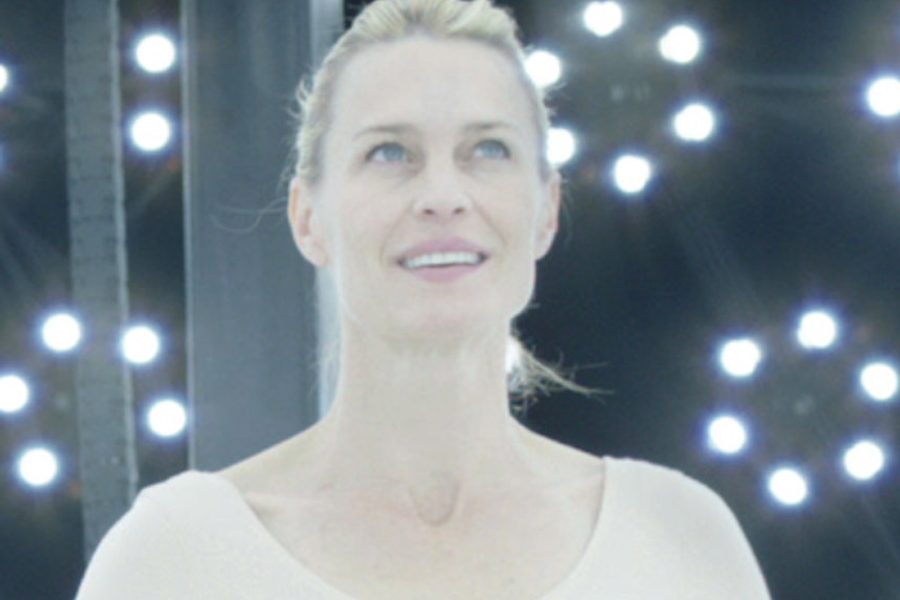The Congress of Collective Hallucinations
In Ari Folman’s new film, fantasy is a slippery slope.
Jude Ellison Sady Doyle

The Congress—director Ari Folman’s sophomore feature, after his universally acclaimed and award-winning “animated documentary” Waltz with Bashir — is almost certainly one of the weirdest movies you’ll see all year. It’s also one of the most beautiful, and the most ambitious; told half in hazy live-action, half in hyper-colorful and visually overstuffed animation, every frame of it is gorgeous when you hit pause. Its storytelling is as innovative as its look; the script takes such huge structural chances that it frequently seems on the verge of collapsing into terminal incoherence, or just plain goofiness, yet it’s intensely rewarding to see a movie try so hard to do something new.
Of course, The Congress might very well be the worst movie you’ll see all year, too. I’m not quite sure yet. The excessive, intentional, overwhelming strangeness makes it kind of hard to tell what “good” or “bad” even means.
The main problem is that The Congress is not exactly one whole movie. It’s at least two or three movies, of wildly varying quality and style, roughly stitched together: a feminist polemic, a ham-handed entertainment-industry satire, a trippy adult cartoon about the nature of truth, and one entirely random bit that just re-enacts Dr. Strangelove for a few seconds.
Which leads us to the second problem with The Congress: Some of the movies sewn into this cinematic Frankenstein’s monster are, indeed, terrible. And I do mean truly, disastrously terrible. Particularly in the middle portions, when Folman becomes convinced he has a stinging sense of satirical humor, we get scenes that would be embarrassing coming from a film-school student, let alone an Oscar-nominated director. Yet many other scenes are very, very good. And, taken in full, the whole huge, shambling mess might actually be brilliant.
So let’s start with the good. One of the stories The Congress wants to tell is a sad, bitter satire of how women are commodified in the entertainment industry. The raw, beating heart of this story is actor Robin Wright, playing a fictionalized version of herself named, yes, “Robin Wright.”
If you want to tell a story about women, age, and entertainment, Wright is an ideal focus. She was a model by 14, an actor by 18, and — thanks to her role as Buttercup in 1987’s The Princess Bride — a movie star at age 21. She was expected to take her place in the pantheon of ubiquitous, super-blonde super-stars, next to Ryan and Basinger and Pfeiffer. Except, of course, for one problem: Robin Wright didn’t want to be a movie star. She wanted to act.
“They wanted to make me America’s sweetheart,” Wright recently told the Guardian. “They wanted to make me the next big ingenue, the studio bosses behind the curtain. But what happened was that I turned down a lot of movies that simply didn’t blow my dress up. Plus I was busy being a mom at the time.”
In the decade or so that followed The Princess Bride, Wright reportedly turned down around 14 projects: Jennifer Grey’s role in Dirty Dancing, Liv Tyler’s role in Armageddon, Nicole Kidman’s role in Batman Forever, Laura Dern’s role in Jurassic Park. She dropped out of Robin Hood: Prince of Thieves and The Firm, both times because she was pregnant. (William Goldman, writer of The Princess Bride, once publicly blamed Wright’s lack of A-list status on her choice to reproduce: “Barbra Streisand does not get pregnant at such a time.”) She had a rule against taking “sex symbol” roles — “I want people to recognize me for my work, not just for being pretty” — and complained about “always [being] offered the role of wounded, soulful, understanding mother and wife.” She rejected roles where she was “just going to be arm candy or go, ‘I’m sorry, honey, let me get you a beer.’” She was offered the lead on Oliver Stone’s Born on the Fourth of July; during her meeting with Stone, she reportedly told him that he had a problem with women. Instead of making the films that would have established her as a commercially viable actress, Wright took rare, dark, weird roles in small, dark, weird movies that very few people saw. (Even in her one big financial success, Forrest Gump, you get the sense that she took the job for the scenes where she could snort cocaine and try to throw herself off a balcony.) And so the leading-lady offers stopped coming.
Though she swears the “Robin Wright” character in The Congress has very little in common with the Robin Wright who made The Congress—and rightfully so; as soon as her children were grown, Wright left her troubled marriage to Sean Penn, started pitching herself hard again, took a few jobs in groan-worthy “commercial” films like Beowulf, and is currently in full comeback mode, having secured a suitably dark and strange role as Claire Underwood on House of Cards—all of this painful history is invoked on screen. The real Wright’s legitimate concerns about selling out are portrayed here as the bad decisions of a chronic fuck-up. We meet the washed-out actor when she is given one final offer before being permanently blacklisted: She can earn enough money to live out the rest of her life in wealth and comfort, on the condition that she gives up any attempt at creative control, forever. Her “difficult” personality will be removed from the equation, because her image will be scanned into a computer, and will become — as far as the public is concerned — the “real” Robin Wright. This avatar will make any movie the studio likes, without complaining. It will stay young forever, something the flesh-and-blood Robin Wright cannot do. Her image has value, her ambitions do not: “I need Buttercup from The Princess Bride. I need Jenny from Forrest Gump,” the head of the studio tells her. “I don’t need you.”
The movie starts off on a precious note: Every single actor is given a Big, Dramatic Monologue to show off their chops, and Wright’s fictional children communicate in the implausibly wordy, “precocious” movie-kid dialect that makes you want to ship the little brats off to boarding school. But there’s still a compelling bitterness to these opening scenes. There’s a story in here about how the artistic ambitions we reward in men are seen as “difficult” behavior in women, about how women in entertainment are treated like disposable commodities, about how, no matter how hard she works or how talented she is, a woman who looks like Wright will always be primarily valued as a pretty face. It’s when Wright accepts the offer to transition from actor to object, in order to pay for her disabled son’s medical care, that the movie turns into something else entirely.
It also goes completely off the rails. We transition, abruptly, from live action to animation, and from realism to surrealism. We jump forward twenty years in time, to a bizarre sci-fi premise, and then – just as we’re getting used to it – jump forward twenty more years, to an even more bizarre premise, without either one being adequately explained. We’re never entirely sure whether what we’re seeing is real, or a delusion, or whether the difference matters. It’s an adaptation of a novel — Stanislaw Lem’s The Futurological Congress—except that all of the characters, and the plot, and the premise, are not from that novel. Essentially, The Congress starts out as Spike Jonze’s Her, and turns into Richard Linklater’s Waking Life, without bothering to make sure the audience can follow.
Somehow, actor-scanning has resulted in a dystopia where movie studios run the world. These movie studios conduct their business in “animated zones,” which is to say, zones where everyone is on hallucinogenics that allow them to see the world as they wish and transform their appearance into whatever they like. (“Whatever they want” invariably looks like a hand-drawn cartoon, because, sure, why not?) Robin Wright is invited to one of these “animated zones,” presumably to renew her scanning contract, only to find that the studio now wants to license the right to fantasize about her – via chemicals that will, somehow, simulate her physical presence in their lives – or to physically become her. Their plan is to hook the populace on hallucinogenic drugs, including drugs that allow them to hallucinate being their favorite celebrities, thus transforming the entire world into a consensual hallucination, which will be … bad. Somehow. Probably. Honestly, it’s hard to tell, because aside from some painfully hacky “satire” of our current media climate — including a technology-presenting villain named Reeve Bobs—the main point seems to be giving Robin Wright “incurable hallucinogenic poisoning,” thus catapulting the audience into a series of lavishly animated dream sequences and forcing us to bid farewell to narrative coherence forever.
Wright-the-actor does her best to hang on as the movie dissolves around her. Of all that I could say about her talent, perhaps the highest praise is that she manages to deliver astoundingly stupid lines like “Soon you’ll be able to drink me as a milkshake! WAKE UP, PEOPLE” with something like conviction. But it’s only once The Congress has fully shaken loose from realism and transferred us into that hallucinogenic world that you get a sense of what Folman really wants to do: not tell a story about one woman selling out, or even about women in the media, but interrogate the value of “authenticity.” Choosing unreality, he seems to imply, is a slippery slope: If you can get plastic surgery to look younger, why not just manufacture a perpetually young image of yourself? But if you can manufacture an image of yourself, why not just look like someone else? But if you can look like someone else, why not be someone else? Why see anything as it is? If you can live in your version of a “perfect world,” why bother with this one?
It’s women who are most pressured to be, or seem, something other than they are, which is why it makes sense to start the drift away from reality with a woman’s story. (Not that the movie’s gender politics are perfect: Jon Hamm gives a surprisingly moving voice-only performance as a man who’s fallen in love with Wright by animating her avatar, but it’s hard to avoid the fact that he’s essentially a stalker who’s “researched her obsessively.” That’s a pick-up line that not even Jon Hamm can sell, yet we’re apparently supposed to interpret his creepiness as a sign of true love.) But the movie’s core concerns about how much reality we can tolerate — and how much of it we should be expected to take — are relevant to anyone. The “real” world, if it exists, is full of poverty and suffering; the hallucinated world is a paradise; the real world probably can’t be fixed, but the comforts of the hallucinated world prevent anyone from even trying to fix it. The Congress refuses to take sides or provide answers, but as it slips further and further away from reality, we become so entirely accustomed to Folman’s hyper-pretty cartoon world that seeing a real human face is a startling, even depressing experience. Folman’s hyper-real, gorgeous animated universe is so unceasingly pretty that ordinary human flesh looks ugly and drab by comparison.
That shock conveys the movie’s point far more effectively than any of Folman’s dippy “philosophical” dialogue. Giving up the real world to experience “happiness” might be irresponsible, self-destructive, or delusional. But, given the world we have to work with, it might also be the only option we have.
Jude Ellison Sady Doyle is an In These Times contributing writer. They are the author of Trainwreck: The Women We Love to Hate, Mock, and Fear… and Why (Melville House, 2016) and was the founder of the blog Tiger Beatdown. You can follow them on Twitter at @sadydoyle.








